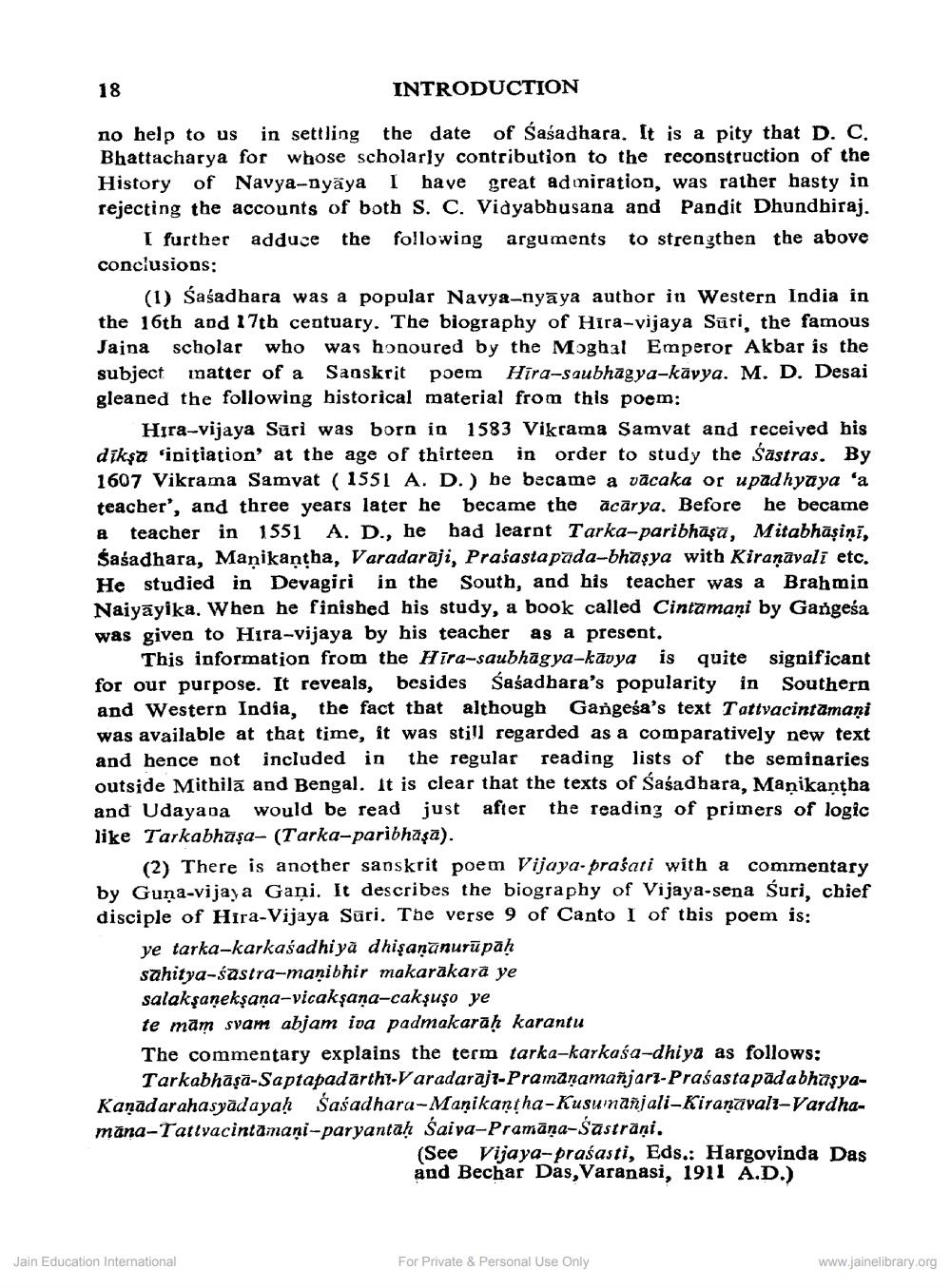________________
18
INTRODUCTION
no help to us in settling the date of Śaśadhara. It is a pity that D. C. Bhattacharya for whose scholarly contribution to the reconstruction of the History of Navya-nyaya I have great admiration, was rather hasty in rejecting the accounts of both s. C. Vidyabhusana and Pandit Dhundhiraj.
I further adduce the following arguments to strengthen the above conclusions:
(1) Śaśadhara was a popular Navya-nyāya author in Western India in the 16th and 17th centuary. The biography of Hira-vijaya Suri, the famous Jaina scholar who was honoured by the Moghal Emperor Akbar is the subject matter of a Sanskrit poem Hira-saubhagya-kavya. M. D. Desai gleaned the following historical material from this poem:
Hira-vijaya Sūri was born in 1583 Vikrama Samvat and received his diksa 'initiation' at the age of thirteen in order to study the Šāstras. By 1607 Vikrama Samyat (1551 A. D.) be became a vācaka or upadhyaya 'a teacher', and three years later he became the acārya. Before he became a teacher in 1551 A. D., he had learot Tarka-paribhaşā, Mitabhāşini, $aśadhara, Manikantha, Varadaraji, Prasasta pada-bhaşya with Kiranavali etc. He studied in Devagiri in the South, and his teacher was a Brahmin Naiyāyika. When he finished his study, a book called Cintamani by Gangesa was given to Hira-vijaya by his teacher as a present.
This information from the Hira-saubhagya-kavya is quite significant for our purpose. It reveals, besides Śaśadhara's popularity in Southern and Western India, the fact that although Gangeśa's text Tattvacintamani was available at that time, it was still regarded as a comparatively new text and hence not included in the regular reading lists of the seminaries outside Mithila and Bengal. It is clear that the texts of Saśadhara, Manikantha and Udayana would be read just after the reading of primers of logic like Tarkabhāşa- (Tarka-paribhāsā).
(2) There is another sanskrit poem Vijaya. praśati with a commentary by Guna-vijaya Gani. It describes the biography of Vijaya-sena Suri, chief disciple of Hira-Vijaya Suri. The verse 9 of Canto I of this poem is:
ye tarka-karkasadhiyă dhişananurüpah sahitya-sastra-maņibhir makarakara ye salakşanekşana-vicakşana-cakşuşo ye te mam svam abjam iva padmakarāḥ karantu The commentary explains the term tarka-karkasa-dhiya as follows:
Tarkabhāșa-Saptapadartht-Varadarajı- Pramanamañjari-Praśasta padabhaşyaKanadarahasyadayah Śaśadhara-Manikantha-Kusunanjali-Kiranavalı-Vardhamana-Tativacintamani-paryantah Saiva-Pramāna-Sastrāņi.
(See Vijaya-prasasti, Eds.: Hargovinda Das and Bechar Das, Varanasi, 1911 A.D.)
Jain Education International
For Private & Personal Use Only
www.jainelibrary.org




